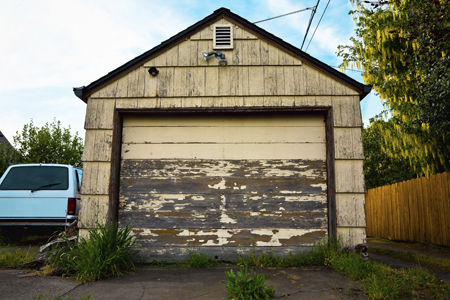
Your garage door doesn't need to reach this condition before it starts to squeak!
A squeaking or screeching garage door is an annoyance to the owner and any neighbouring properties. It's also a sign that the door needs some maintenance - fortunately, the associated tasks are easy with the right tools and advice.
Squeaking is generally a sign that some of the parts that lift and lower the door do not have enough lubrication. Since it's hard to access which parts in particular are producing the noise, it pays to lubricate all moving parts - after all, you have everything you need out and ready to go!
Use the right lubricant
A common mistake people make is using WD-40 to lubricate their moving parts. WD-40 is a water and oil-repellent spray - and, as such, will prevent the much needed grease from sticking to these parts. Instead of WD-40 use a lithium or silicone spray. These provide a much thicker coating that will stick to the moving parts for longer.
Safety first
Before you begin, create a safe working environment by ensuring:
- the area is well-lit
- you can easily and safely reach all moving parts using a stool or step ladder
You'll also need to disconnect the door from the automatic opener, to prevent anyone accidently opening it while you're working on it. The vast majority of doors have a rope with a handle hanging down from the opener - a gentle pull will disengage the motor.
Lubricate the moving parts
1) Moving the door manually, spray all the moving parts, including the hinges, pivot points, stems, nubs, locks, and arm bar.
2) Check the rollers. If they are made from plastic, don't worry about them, greasing them won't achieve much. For metal rollers, use the nozzle extension on the lubricant and make sure you get the lubricant inside the ball bearing casing.
3) Lubricate the pulleys and move the door up and down a few times to work the lubricant into all the parts.
4) Don't lubricate the chain of the garage door opener - it should have a protective coating on it that will last the lifetime of the chain.
5) Lubricate the top of the rail, but not the bottom - nothing should be 'wearing' against the bottom and you'll just end up dripping lubricant on your head.
6) Don't grease the tracks - it’ll make them slide too much. It will also pick up dirt and dust from the outside, eventually clogging the track. If the tracks do appear grimy, you can wipe them down with a damp cloth, brake cleaner or WD-40. If it appears that there's some reason to grease the tracks, there's something wrong with the door.
Torsion spring maintenance
If you feel your torsion spring needs maintenance, it's best to contact a professional - these parts are under immense pressure and should not be tampered with.

